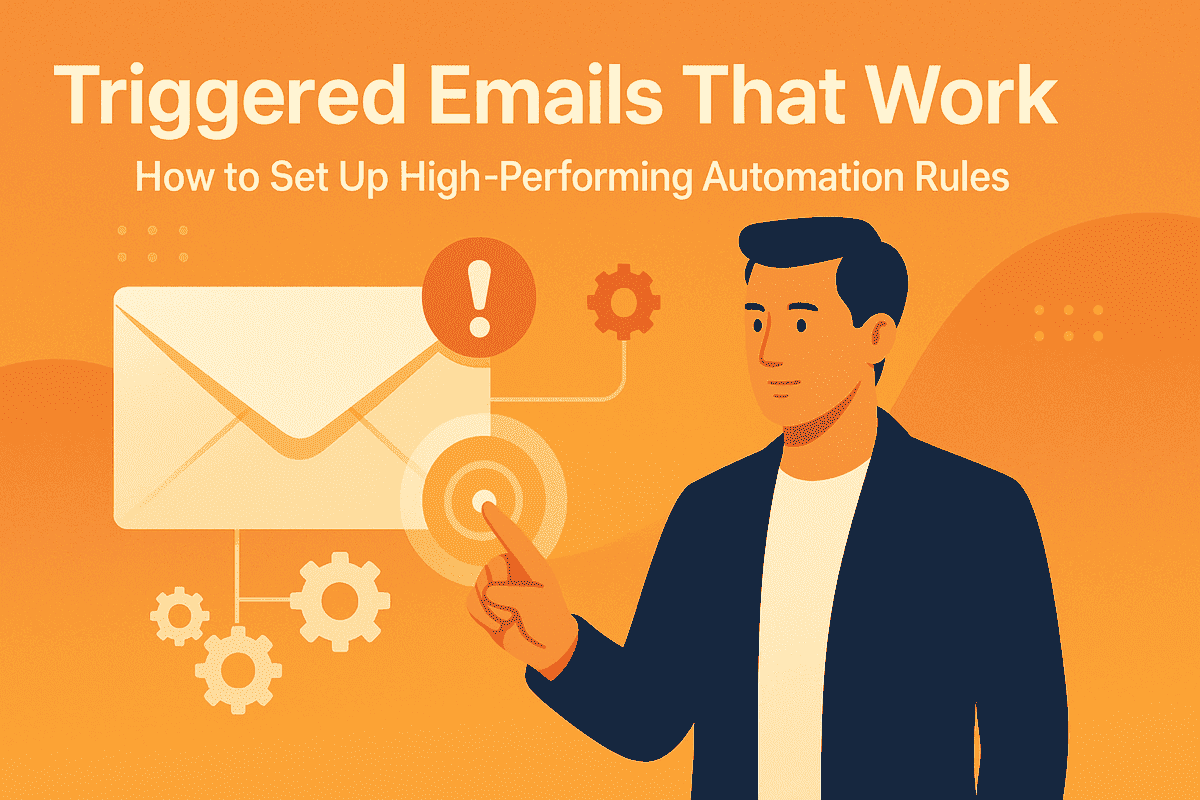Why Timing Matters When It Comes to Email Marketing
Consider this — a customer adds something to the cart but fails to complete the sale. A few minutes after they do that, they get a polite reminder email with a promotion code. They proceed with the purchase immediately. That's the strength of a well-timed, triggered email.
Triggered emails—also known as automation or behavior emails—are the success or failure of your email marketing campaign. They're not just automation; they're about putting the right message in front of the right person at the right time.
But how do you use them effectively? That's what we'll be discussing.
What Are Triggered Emails?
Triggered emails are personalized messages that are delivered automatically on the basis of user behavior, activity, or a specific event. Unlike newsletters that are delivered at a scheduled time, triggered emails react in the moment, delivering hyper-relevant content to subscribers.
Common Trigger Types:
- Welcome emails at registration
- Abandoned cart reminders
- Post-purchase follow-up
- Re-engagement reminders
- Account activity notifications
They're personal. They're timely. And they deliver better than bulk campaigns in open rates, click-throughs, and ROI.
Why Triggered Emails Matter for SMBs
For SMEs, triggered emails are the secret to doing more with less. Here's why they matter:
- Earn more money without extra effort: Automate sales closings and upsell touchpoints.
- Improve customer experience: Personalized messages build trust and loyalty.
- Save time and scale: Configure once, they run without constant monitoring.
- Increase engagement: Live responses read as personal and proactive.
Fact: Triggered emails are 70.5% more likely to be opened and 152% more likely to be clicked than traditional marketing emails.
Top Trigger Situations That Drive Conversions
Not all triggers are created equal. Some convert better than others.
High-Impact Triggered Emails:
Make a fantastic first impression. Make a statement about your brand and product.
Recover lost sales with reminders and incentives.
Cross-sell, request reviews, or send valuable information.
Alert dormant users with value-driven messages.
Personalized touches that foster loyalty.
Leverage browsing or purchase history for upsells.
Pro Tip: Mix behavior + timing. E.g., "If inactive for 30 days and clicked on X, send re-engagement."
How to Set Up High-Performing Automation Rules (Step-by-Step)
Let's take a real-world setup for triggered email automation.
Select Your Trigger
Start with these questions:
- What's the user action you're triggering a response for?
- What's your objective (conversion, retention, upsell)?
Segment Your Audience
Use criteria like:
- Behavior (clicked, purchased)
- Demographics (location, age)
- Engagement history
Write the Email Copy
Make it:
- Personalized
- Valued-focused
- Short and concise
- Action-driven (strong CTA)
Determine the Timing
Examples:
- Cart abandonment: 1 hour later
- Follow-up: 2 days after purchase
- Re-engagement: 30 days of inactivity
Test and Optimize
Use A/B tests for:
- Subject lines
- Timing
- Copy variations
- Call-to-action buttons
Best Practices for Triggered Email Campaigns
Plan strategy first, then automate. Here's what works best:
- Use a straightforward naming convention for flows (e.g., "Cart-Abandon-1hr").
- Have fail-safes in place to avoid email fatigue (don't send 3 automations daily).
- Mobile-first design — over 60% open on mobile devices.
- Plain text + imagery — a combination keeps it organic but engaging.
- Measure KPIs like open rate, CTR, and conversion per trigger rule.
Common Mistakes to Avoid
Don't get caught in these pitfalls:
- Sending too early or too late (timing makes everything)
- Generic, non-personalized messaging
- Overshooting segmentation
- Forgetting to test subject lines
- Not keeping automations up to date as your business evolves
Tools to Create and Refine Triggered Emails
You don't need the entire dev team. These tools do the heavy lifting:
Klaviyo
Ideal for ecommerce triggers
ActiveCampaign
The all-in-one CRM + automation
Mailchimp
Easy workflows for beginners
ConvertKit
Ideal for creators and digital products
HubSpot
Enterprise-scale features for scaling
FAQs
Q1: What is the difference between drip and triggered emails?
A triggered email is sent based on a specific action. A drip email is a pre-set drip regardless of behavior.
Q2: How many triggered emails do I need to set up?
Start with 3–5 high-impact ones (welcome, cart, follow-up) and expand over time.
Q3: Do I need customer data to send triggered emails?
Yes, you'll need behavioral or profile data to trigger the proper message.
Q4: Are triggered emails applicable to service-based companies?
Yes! Make triggers for consultation appointments, reminders, or review requests.
Q5: How often should I review my automation rules?
Every quarter is a good benchmark. Update based on performance stats and business changes.
Conclusion & What's Next
Use of high-performing triggered emails isn't just smart — it's imperative.
When done well, they're like a handwritten note that comes at exactly the right time. For U.S.-based SMBs, they are a game-changer — accelerating growth, retention, and brand loyalty.
Ready to automate smarter? Start with one trigger today, and build from there.

